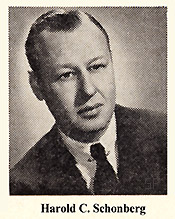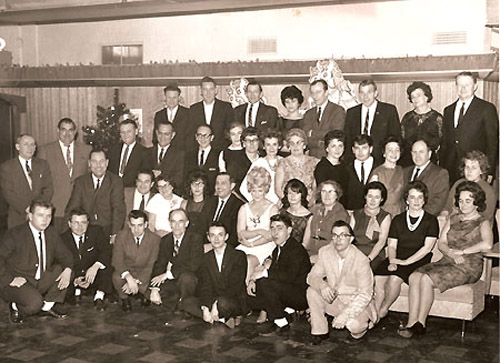|

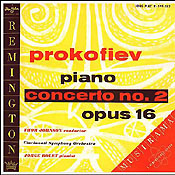
The cover of Jorge Bolet's
recording of Prokofiev's Opus 16.

The excellent recording
of Liszt's Concerto No. 1 and Totentanz (archaic Todtentanz), Variations on Dies
Irae, played by Edward Kilenyi.
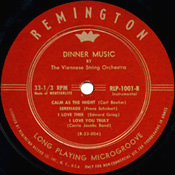


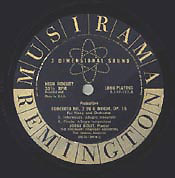
The
first pressings on the Musirama label are thick and do not have the groove guard. 
Later
pressings on the red and blue Musirama labels are generally of less quality compared
to the first black Musirama label because different electronics were used. 
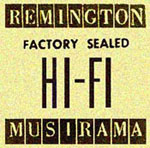

Violinist
Ossy Renardy is accompanied by Eugene List in the Violin Sonatas of César
Franck and Maurice Ravel on R-199-148. 
Remington
R-199-161 with Jorge Bolet playing Chopin's Four Scherzi. 
Ossy
Renardy plays Paganini Caprices with Eugene Helmer at the piano. 
Remington
R-199-184 

|
In
1995 I wrote an article about Remington Records and called it "Obscure Adventure",
indicating that for a long time hardly any fact was known to me and to many other
collectors about the owner of the label, the way the recordings were produced
and manufactured, and that only a few details about just a few artists were available. In
"Ideas that became big business", written by Clinton Woods (Founders Inc., Baltimore,
1959), many brands like Coca-Cola, Black & Decker, Goodyear, Hertz, Singer
and Steinway, and pioneers like Bell, Otis and Schaeffer are well documented.
The only Remington brand names are those of the typewriter manufacturer, and of
course of the rifle industry which in time of war speeded up their production.
But the author does not deal with phonographic patents and successes. Columbia's
invention of the long playing record is never mentioned. Apparently the general
perception was that the record business was not a big business at all.
| |
| Image
taken from a High Fidelity Magazine issue from the early 1950s. |
So
I had to be contented with a few record magazines from the nineteen fifties that
were available in Europe. Most of the time there was hardly any information on
the back of the LP covers, except for the listed titles and reference numbers.
Only in a few encyclopedia there were entries about conductor Kurt Wöss
and violinist Michèle Auclair and it was mentioned that these performers
had recorded for the Remington label. Even Harold C. Schonberg, writing
the paragraph on Jorge Bolet in his book "The Great Pianists", never mentions
the recordings Jorge Bolet made for the Remington label in 1953. And the local
public library had practically no reference books on artists and orchestras and
the recordings they had made. When I started researching further on the internet
in 1999, chances finding details were very rare. Only the Library of Congress
had files showing names and numbers, but most disappeared already a few years
later when the LOC restructured their filing system and reviewed what would
be on the net and what not. Wikipedia did not exist yet. Only
gradually more names of artists were being mentioned on general pages, on homepages
of pupils who studied with pianists and violinists, on pages of scholars who had
done some research in a specific field. And when Wikipedia came into being more
info could be found, often triggered by the existence of The REMINGTON Site.
For quite some time there were records released by Tom Null on the
Varèse Sarabande label. But these were not available in Europe. Later APR
issued old recordings of a few artists like Edward Kilenyi and Simon Barere, but
only much later CDs of more original recordings have been issued by Bearac
Records, APR and Re-Discovery. It
is as if the artists concerned forgot about the Remington recordings they once
made. And if they were still alive, they probably did not recall that they recorded
for the label as this could be considered by some a false step in their careers,
or they were not even aware of the fact that their performances were being released
on a cheap American label. The information I read about Michèle Auclair
at the time provided by Coupe d'Archet does not mention a single Remington recording.
Maybe
a few artists would still be alive and could provide more information. So I started
writing letters, searching the telephone directories and just called and spoke
to several of them on the phone already in 2000 and 2001.
Most musicians I
contacted were responding positively, except for Gérard Poulet, and also
for Michèle Auclair, after writing many letters and many telephone calls
to Boston and Paris, and leaving messages on the answering machine of the late
violinist.
At the time the only web site that mentioned Frieda Valenzi
was the one of duo-pianists Krassimira Jordan & Thomas Kreuzberger. Kreuzberger
had studied with Frieda Valenzi. They forwarded my e-mail to conductor/pianist
Roswitha Heinze and from her I received information about Frieda Valenzi
and we started a correspondence. I
talked very shortly to Laszlo Halasz and extensively to his wife, cellist
Suzette Forgues. She was still active as a teacher at the time.
I
called up Alexander Jenner in Vienna one Sunday afternoon and he gave me
important details and images sent by his son. I spoke to Conrad Hansen
in Hamburg on the phone as well.
Dominique Chailley, grandson of pianist
Céliny Chailley-Richez, send me an extensive article he had just
finalized from which I could use several details.
Violoncellist Ursula
Erhart-Schwertmann, daughter of pianist Hermann Schwertmann, sent biographical
notes and pictures of her father.
With pianist Felicitas Karrer I
corresponded and had several telephone conversations. She was managing the garage
her father had built. After she had seen the page she sent me a Sachertorte,
the Viennese chocolate cake, to express her appreciation. It arrived well packed
in its original wooden box.
Graphic artist Alex Steinweiss sent me
an overview with data of his career.
Esa Haapa-Aho
from Finland send me a few photocopies of old photographs and of a few newspaper
clippings which were all printed in a book from way back. They dealt with the
history of the Helsinki University Chorus (Ylioppilaskunnan Laulajat).
These
and more were contacted at one time or another and generally they responded in
a positive way. Right from the start in 1999 the pages invited anyone, who had
a reminiscence or knew specific facts about the label and its creator Don Gabor,
to contribute. The basic layout was designed then and the design of the pages
has changed only in minor details. That was before Wikipedia started with its
global concept encompassing a multitude of encyclopedic subjects and created a
professional basic layout. Several
pupils and acquaintances of pianists, violinists, conductors and teachers responded
positively, directly themselves or through colleagues. I also had a few telephone
conversations with record producer Tom Null of the Varèse Sarabande
label in California. He gave me a few details and he suggested that I find and
call up Mr. Laszlo Halasz.
Violin teacher Patricia Jaeger from
Seattle sent me details and a comment on the Young Violinist's Series and stressing
the importance of such an instructional series.
Many
others supplied details as well, about a record cover or a name, they wrote a
personal recollection, or a more extensive contribution, as Ryan Barna
did about Polka King Frank Yankovic. Lory Wallfisch responded to
the Enesco page. Regina Resnik wrote about how her carreer started under
maestro Fritz Busch.
Timothy Gaspar sent me an interesting article
written in 1951 by journalist Cecil Smith published in The New Republic.
Stéfanos Theodoridis from Greece saw the page about Alice and Theodore
Pashkus and send me photographs owned by his teacher Yorgos
Manessis who had studied himself with Alice Pashkus, and Stéfanos
added a few details.
Professor Dr. Marco de Vries visited Helen Airoff
in London and later founded the Helen Dowling Institute in Rotterdam, The Netherlands.
He gave me copies of a letter written by Yehudi Menuhin and two photographs of
Helen.
These people submitted valuable information. They are all listed on
the previous page. It
is not surprising that information is scarce. First of all the label existed only
for eight years in the early days of the LP era. Secondly: the quality was far
from first rate. And thirdly many labels did not like the competition they got
from Remington because the releases were low priced. Remington was ignored by
the other big labels, yet at the same time the other labels wanted to make life
rather difficult for its owner, Don Gabor.
Robert Angus told me, that
if somebody would ask the proprietors of a local record shop to stock, or at least
to order more Remington titles, without exception they all refused. They already
had been told by the sales representatives of the distributors of Victor
and Columbia that if
they would continue to do business with Don Gabor, they
would lose their franchises for these quality labels .
| |
| Personnel
of Remington's Webster pressing plant in Massuchsetts and their relatives at the
1957 Christmas party. | This
position may have strengthened Don Gabor in adopting less common ways of recruiting
artists and acquiring taped performances: "He would take anything he could
lay his hands on", discographer David Diehl told me. And that was
certainly the case when the label was discontinued and Don Gabor released all
sorts of music on his other budget labels. There
are only a few Remington recordings which had been released by other record labels
first, like excerpts from Bach's Christmas Oratorio conducted by Hans Grischkat
which was released on R-199-155, but had been issued by Renaissance on SX 201.
The plates of the complete performance were bought by Gabor from Renaissance.
There is the recording of Symphony No. 3 of Anton Bruckner which was first issued
on Concert Hall Society and later on Remington.
Gabor
had his own ways of mass production and of stimulating sales. He used
a cheap low quality substitute for vinylite named "websterlite",
he continuously had the record covers restyled, suggesting that the
releases were new recordings, and on top of that, he simultaneously
issued a number of the same performances on other labels he created,
Plymouth, Merit, Masque, Etude, Masterseal, Buckingham, Paris, Pontiac,
Webster, etc.
| |
| The
label of the 1956 release with works by Ward and Stein says: HIFI by WEBSTER.
The words Living Sound were of course deliberately chosen.
The record is
pressed from the original plates of the Remington American Composers release R-199-185. |
The competition he faced could have intensified certain less positive
traits of his character. When I asked Mrs. Wilma Cozart Fine
of Mercury Living Presence Records about Don Gabor and Remington
Records, she said: "Oh, those people". This reaction is quite understandable.
When Don Gabor started off with the Remington label it soon became
the independent label with the largest turnover.
"Aiming
at mass distribution, he persuaded Macy's to place a trial order for 20.000 records.
They were sold in a single day(...)", Cecil Smith reported in the NEW REPUBLIC
of April 23, 1951. Smith evaluated a batch of Remington releases in an article
called Low-Priced Records. His conclusion: out of 21 records only 8 were more
or less acceptable. The article clarifies how clever Gabor was in selling large
quantities. See  MUSIC: Low-Priced Records.
MUSIC: Low-Priced Records.
Yes,
Gabor did not have a large network like the big labels had (though
he had representatives in important cities), nor did he have too much
personnel (at least in the beginning of his enterprise, but the Webster
pressing plant soon had a large number of workers), and the artists
who recorded for him were not too expensive, although Viennese producer
Marcel Prawy was paid generously by Gabor. Furthermore the works were
mostly in the public domain. And as mentioned before: he used that
cheap kind of vinyl.
By listening to the Remington releases one easily can hear that Don Gabor did
not care much about the sonic quality of the product and that he had his own ideas
of what a long playing record should represent. Nevertheless he can be considered
as a kind of pioneer, not in microphone placement as C. Robert Fine of
 Mercury
Records was, and not in tackling the problem of inner groove distortion
as technicians of RCA did. No, Don Gabor was the man who turned Columbia's freshly
invented LP more or less right from the start into a medium with Music for
Millions. He quasi reinvented the LP. Mercury
Records was, and not in tackling the problem of inner groove distortion
as technicians of RCA did. No, Don Gabor was the man who turned Columbia's freshly
invented LP more or less right from the start into a medium with Music for
Millions. He quasi reinvented the LP.
Gabor's
marketing strategy was probably reinvented every time the circumstances
dictated a new move. And he acted along the lines 'not the quality
of the cheese has to be improved upon, no, people have to eat more
cheese', the common marketing strategy which was later described
and attacked by Vance Packard in his book "The Hidden
Persuaders" (1957).
We
should not forget that in the early nineteen fifties records were generally played
on gramophones with a crystal or ceramic pick up cartridge with a frequency curve
which showed an early roll off. And the amplification was mostly provided by a
simple radio or a tiny valve amplifier and a high efficiency loudspeaker or on
a portable gramophone.
The fact that Don Gabor overlooked the importance of sound quality was an omission
that kept him, regrettably, from establishing a label that withstood the changes
of time. In hindsight however there are a few items in the original catalogue
that should be seen as unique - in some instances because of the work that was
recorded, but most of the time specific items have their importance because of
the artists who were talked into performing for the label. Some artists played
their last song like Simon Barere, or were of age, like pianists Etelka
Freund and Ernst von Dohnányi, violinists George Enesco
and Albert Spalding, singers Karin Branzell and Anne Roselle.
There were also artists who tried to pick up their careers which were so brusquely
interrupted by World War II, as was the case with pianists Jorge Bolet
and Edward Kilenyi (both enlisted in the US Army during World War II).
Or they were of the younger generation, artists who just stood at the beginning
of their careers: violinists Michèle Auclair and Gérard
Poulet, pianists Alexander Jenner and Jörg Demus, and conductor
Wolfgang Sawallisch, just to mention a few.
The extraordinary thing about Remington Records is that there are quite a few
artists on it, who show their early or late in life insights by just playing without
the artificial splicing and the use of special techniques to embellish the recording,
but with the relatively limited quality of the recording technique used in those
days. Yet several Remington discs bear the impact of their art.
When people discover The REMINGTON Site, they all too often think that any Remington
record is a collector's item and as such has high value on the second hand market.
Like the owner of a Canadian store who copied half of a page from The
Remington Site without asking me for permission and put a price tag on the record
that is far too high for the disc in question as it is not at all a collector's
item.
Most
recordings are not more than the reflection of the recording and marketing practice
of the early nineteen fifties. Not all music is well performed and most of the
time not too well recorded. Yet the collector of early LP covers can eat his heart
out. For
performances there are some very interesting exceptions of captivating recordings
made by various artists. Many times they are of historical interest as in case
of violinists Georges Enesco who recorded Sonatas and Partitas of J.S.
Bach, and Albert Spalding, and pianist Ernst von Dohnanyi playing
Brahms Sonatas and Hungarian Dances.
Talking about Albert Spalding,
his recordings of the Concertos of Beethoven and Brahms are very good performances
of a violinist at the end of his career.
Michele Auclair playing Tchaikovsky's
Violin Concerto, Op. 35, has all the strong intentions and passion of a young
violinist, educated in the Russian School. Her recital recordings are just wonderful,
have the same intensity plus the strength and refinement she displays very well,
accompanied by veteran pianist Otto Schulhof.
César Franck's Variations Symphoniques
played by pianist Frieda Valenzi and conductor Jean Moreau (I assume
that the conductor is Jean Morel) are wonderful, despite the many irregularities.
Franck's Symphony in D conducted by Hans Wolf is captivating.
The performance of Prokofiev's Piano Concerto No. 2 with Jorge Bolet and
Thor Johnson, goes to the core of the score, as does the reading of Gershwin's
Concerto in F by Alec Templeton, the serious mood Templeton and Johnson
achieve is not easily emulated. And there is Thor Johnson's impressive rendering
of Dvorak's Symphony Op. 88 especially advised in the transfer by Tom Null, issued
on the Varèse-Sarabande label.
Edward Kilenyi's performances
of Liszt's Concerto No. 1 and Todtentanz (Dance macabre/Totentanz) are also very
good recordings, as is his Hungarian Fantasy.
Jonel Perlea conducting
the RIAS Symphony Orchestra in Tchaikovsky and Saint-Saëns is well controlled,
but beautiful.
Mozart Concertos are well performed by young violinist Gérard
Poulet and his father, Gaston Poulet, conducting.
Violinist André
Gabriel - who in fact is Roman Totenberg - gives an impressive, at times almost
intimate, performance of the Violin Concerto of Alexander Glazunov, extremely
well accompanied by Georg Ludwig Jochum leading the RIAS Orchestra.
Alexander
Jenner plays a deep felt Beethoven and a youthful Chopin. Bach played by
Jörg Demus has leanness and transparency.
And there is of course
Simon Barere, dramatically playing Liszt's Sonata in B.
Friedrich
Wührer gives a fine, though not intimate, performance of Beethoven's
4th Concerto. Sylvia Marlowe recorded Rameau, Felicitas Karrer was
the soloist in the Great Concertos and especially her Grieg is well worth listening
to. Pianist Hermann Schwertmann played Tchaikovsky's Op. 23 with
refinement. George Sebastian conducted a strong Berlioz (Symphony Fantastique).
And you may discover more: legendary Fritz Busch, singers Mona
Paulee, Kurt Baum and Ettore Bastianini.
The most famous recording
produced by Don Gabor is of course the 3 LP Box with the Sonatas & Partitas
by Bach performed by legendary Georges Enesco. This set was originally
issued on the Continental label and appeared much later on the Remington
label as well. A few recordings have been issued by Tom Null on the Varèse-Sarabande
label. It is not bad idea to search for these "modern issues"
of old Remingtons with works by Dvorak, Enesco, Dohnanyi, Liszt, Korngold, etc.
Varèse-Sarabande
label. It is not bad idea to search for these "modern issues"
of old Remingtons with works by Dvorak, Enesco, Dohnanyi, Liszt, Korngold, etc.
 Most records offered by sellers
on various auction sites are of course second hand and have often been played
in the past on simple equipment with a ceramic or crystal cartridge with low compliance,
as was the custom in the early nineteen fifties. Therefor the groove is often
damaged although this is not always discernible just by looking at the surface.
Pressings that still have reasonable quality usually come straight out of the
collection of a serious music lover who took care of the records and only played
them on quality equipment. But these records are hard to find.
Most records offered by sellers
on various auction sites are of course second hand and have often been played
in the past on simple equipment with a ceramic or crystal cartridge with low compliance,
as was the custom in the early nineteen fifties. Therefor the groove is often
damaged although this is not always discernible just by looking at the surface.
Pressings that still have reasonable quality usually come straight out of the
collection of a serious music lover who took care of the records and only played
them on quality equipment. But these records are hard to find.
Some
sellers ask exorbitant prices for common material. Most of the time these prices
are definitely not in relation to the offered quality of both engineering, performance
and historic value. These sellers have been inspired by the existence of The REMINGTON
Site, not by love for music, sound judgment and knowledge (otherwise they would
not spell the names of the artists wrong). If the price is high, always ask what
the return policy is beforehand. And: read what the description is. VG ++ is not
the same for all sellers. And beware of Remingtons described as Near Mint! R.A.B.
|
As
a young teenager I grew up with records of Philips, English Decca and
Deutsche Grammophon Gesellschaft. Philips was agreeable. Early Deccas had
a rather dull sound. The perception of these qualities was caused by the playback
equipment of which the frequency characteristic was not very extended. And I did
not like the dark sound of the DGG LP's too much. One evening I attended a special
demonstration of a Philips hi-fi set consisting of a big cabinet containing two
full range 9710 AM 800 Ohm units connected to the Philips amplifier, in
fact directly to the tube circuit without the interface of a transformer (OTL).
The system also had two small boxes reproducing the upper mid frequencies and
highs. They were hanging on the wall on each side of the big loudspeaker cabinet.
When
listening to this system, I did not fail to tell the people from the store that
the sound of the Deutsche Grammophon LP of Tchaikovsky's 2nd concerto played by
Shura Cherkassky sounded much too "dark and boomy".
How did I,
as a 14 year old know? Well, I visited the school concerts which were given in
the concert hall of my hometown. My parents took me to recitals of famous pianists
like Béla Siki, Clara Haskil, Cor de Groot and Stefan Askenase.
And a few years earlier I had sung in the boys' choir in Bach's St.Matthew
Passion performed at Easter conducted by Hans Brandts Buys. On top of that
my brother played the violin. I
pretended to know what the sound produced by instruments, voices and an orchestra
was like. My perception differed completely from what electronics and big loudspeakers
reproduced. The second Decca series with prefix LXTs and subsequent series had
already better dynamics. It all depended much on the applied playback characteristic
and the equipment. In the early years no standardization was adopted and practically
every label had its own playback characteristic with the (de-) emphasis in the
curve to which the record was cut. Each and every record company had their own
philosophy. So some records sounded dull, others warm, and again others lacked
a firm midband and attack. In comparison the sound of the Remingtons had a more
chiseled character.
And
then there were the Remington Musirama records which were imported in our
country already in 1955 but I got acquainted with many years later. That was when
I came across Prokofiev's 2nd Concerto played by Jorge Bolet and the Cincinnati
Symphony Orchestra under Thor Johnson and was struck by the composition
as well as the performance. The concerto was music to my ears and Jorge Bolet's
way of playing the incredibly complex score with the varying moods and the changes
in pace and presence, became one of my most cherished discs and served as an incentive
to explore Remington's catalog further: Jorge Bolet playing
the Four Scherzi of Chopin, Edward Kilenyi with Liszt's 1st Concerto and
Totentanz (Todtentanz),  Ossy Renardy with Paganini's
Caprices, Alec Templeton in Gershwin's Concerto in F with the Cincinnati
Symphony and Thor Johnson, Jonel Perlea conducting the RIAS Symphony
Orchestra with Saint-Saëns' Carnival of Animals and excerpts from Tchaikovsky's
Swan Lake, and a most captivating recording of the Helsinki University Chorus
singing songs by Jean Sibelius and others.
Ossy Renardy with Paganini's
Caprices, Alec Templeton in Gershwin's Concerto in F with the Cincinnati
Symphony and Thor Johnson, Jonel Perlea conducting the RIAS Symphony
Orchestra with Saint-Saëns' Carnival of Animals and excerpts from Tchaikovsky's
Swan Lake, and a most captivating recording of the Helsinki University Chorus
singing songs by Jean Sibelius and others. Jorge
Bolet performed Chopin not impeccably, though with drive. His interpretation was
devoid of sentimentality. The recording had presence and undeniably showed the
sound of a warm Baldwin piano. Alec Templeton's grand piano was clearly defined
as well and the timpani in the Gershwin Concerto sounded impressive and it had
zest. The sound of Edward Kilenyi's Liszt had weight and firmness in the lower
register and strength and clarity in the top of the keyboard while the orchestral
sound had space and the orchestra responded with quickness. Although these recordings
sounded quite good when played on my simple record player (fitted was a Ronette
crystal pick up) connected to a big valve amplifier with separate power supply
which fed a full range speaker unit housed in  The
Boffle constructed according to the details given in "The Gramophone",
I soon discovered that the bulk of the catalog was not on par with the standard
of these LPs.
The
Boffle constructed according to the details given in "The Gramophone",
I soon discovered that the bulk of the catalog was not on par with the standard
of these LPs. The
management of the record department of the renowned piano shop where I bought
my Musirama treasures were anxious not to offer the lesser Remingtons from stock.
They could be ordered. But I was more or less advised against the purchase of
other releases. When I saw some items like Grieg's Concerto with Felicitas
Karrer in the window of a general store and went in to have a listen, I discovered
a prominent hiss which was then and there an obstacle, despite the wonderfully
poetic performance given by Ms. Karrer and Kurt Wöss. The quality
slogan printed on the cover read Factory Guaranteed, but had really no meaning.
The lady of the store told me that the hiss would wear off after a few playings!
She certainly could not convince me. She obviously had been instructed by her
boss to tell such nonsense.
Yet the temptation to buy a few more of the label
was always there.
First of all because of the price. Wilhelm Kempff with Beethoven's
4th Concerto conducted by Paul van Kempen on a 10" gatefold Deutsche Grammophon
was quite an investment for which I could buy nearly two 12" Remington discs.
That was quite an incentive for a school kid who collected also jazz and big band
music. There
was another attractive aspect of Remington records: the distinguished design
of the label and the covers. On first glance the art work may have looked
a bit childish at times but in most cases had a high artistic quality which was
appealing and did rise the curiosity of any prospective buyer who had some artistic
taste. But the number of my acquisitions did not rise above the items mentioned
earlier together with the LP of Chopin's Etudes Op. 10 played by Kilenyi.
In those days there were only a few Remington recordings which were praised in
the specialized magazines and by a reviewer like Warren DeMotte in his  The
Long Playing Record Guide. And in our national record magazine a couple
of Musirama discs got a good review: Symphonie Fantastique (George Sebastian),
Gershwin (Alec Templeton), Dvorak 4th (Thor Johnson), Tchaikovsky's
2nd symphony (Thor Johnson), Aida with Ettore Bastianini and Franco
Capuana.
The
Long Playing Record Guide. And in our national record magazine a couple
of Musirama discs got a good review: Symphonie Fantastique (George Sebastian),
Gershwin (Alec Templeton), Dvorak 4th (Thor Johnson), Tchaikovsky's
2nd symphony (Thor Johnson), Aida with Ettore Bastianini and Franco
Capuana. Ever
since I was a kid my curiosity about the label and its owner was aroused but not
satisfied. When I published a book about audio and music in the mid nineteen nineties,
I wrote the article about Remington Records. But when the world wide web became
accessible, it presented the opportunity to publish an entire site about the
label:  The REMINGTON Site. It gives honor to many
artists who would be forgotten and others who receive recognition anew, and it
is a late tribute to its owner, Don Gabor, who in contrast to
The REMINGTON Site. It gives honor to many
artists who would be forgotten and others who receive recognition anew, and it
is a late tribute to its owner, Don Gabor, who in contrast to  Eli
Oberstein and his Allegro Royale bootlegged recordings, really wanted
to produce Music for Millions. Also the label enjoys a sort of renaissance
because of the increasing and new attention it gets since the publication of these
pages which makes people discover that not every Remington disc is a find.
Eli
Oberstein and his Allegro Royale bootlegged recordings, really wanted
to produce Music for Millions. Also the label enjoys a sort of renaissance
because of the increasing and new attention it gets since the publication of these
pages which makes people discover that not every Remington disc is a find. I
wish you happy reading and browsing. Come back any time. You can check the names
of artists on the previous page, or you just can go to the next page and go on
reading. Rudolf A. Bruil - Page
first published in September, 1999 and updated. |

![]() PREVIOUS
PAGE
PREVIOUS
PAGE
![]() NEXT
PAGE
NEXT
PAGE 















